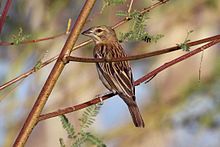Chestnut weaver
| Chestnut weaver | ||||||||||||
|---|---|---|---|---|---|---|---|---|---|---|---|---|

Chestnut weaver ( Ploceus rubiginosus ), male |
||||||||||||
| Systematics | ||||||||||||
|
||||||||||||
| Scientific name | ||||||||||||
| Ploceus rubiginosus | ||||||||||||
| Rüppell , 1840 |
The chestnut weaver ( Ploceus rubiginosus ) belongs within the family of weaver birds (Ploceidae) to the genus of the bunting weaver ( Ploceus ).
The Latin species addition comes from the Latin rubigo 'rust' and the Latin rubiginosus 'full of rust, rust-colored' .
The bird is found in East Africa and in Southwest Africa in Ethiopia , Djibouti , Kenya , Namibia and Tanzania .
The distribution area mostly includes dry habitats with trees or bushes , preferably acacias mostly below 2000 m altitude.
features
The species is 14 cm tall, the male weighs between 28 and 27 g, the female between 25 and 31 g. The male is characteristic in the breeding plumage with a sharply set black head against the dark chestnut brown back and underside. The wings and tail are blackish, with a yellow-brown or yellow border at the tips. The similar chestnut sparrow is significantly smaller and has a very dark brown face. In the plain dress, the male, like the female and young birds, has more brown plumage than other weaver birds, with black stripes on the top and white on the underside and the rump with a broad yellow-brown chest band, dashed in black.
Geographic variation
The following subspecies are recognized:
- P. r. rubiginosus Rüppell , 1840, nominate form - English Northern Chestnut Weaver - western Eritrea , Ethiopia, Somalia, southeastern South Sudan , northeast Uganda, Kenya and Tanzania
- P. r. trothae Reichenow , 1905 - English Southern Chestnut Weaver - south-west Angola , Namibia and rarely in north-west Botswana
voice
The male's song is described as a very short, dry hiss reminiscent of Quelea .
Way of life
The diet consists mainly of seeds, mostly grass seeds, also insects including termites , but also nectar from aloes .
The breeding season is in October in Ethiopia, in May in Somalia, between May and July in Uganda, between April and July in Kenya. One part is a stationary bird , another is a migratory bird or a roaming bird .
The species is polygamous and polygynous , breeds in large colonies .
Hazardous situation
The stock is not considered to be at risk ( least concern ).
literature
- CH Fry and St. Keith (Eds.): The Birds of Africa - Volume VII. , Christopher Helm, London 2004, ISBN 0-7136-6531-9
- A. Craig: Chestnut Weaver (Ploceus rubiginosus) . In: J. del Hoyo, A. Elliott, J. Sargatal, DA Christie & de E. Juana (eds.): Handbook of the Birds of the World Alive. 2019, Lynx Edicions, Barcelona. (retrieved from https://www.hbw.com/node/61008 on 7 October 2019).
Web links
- Videos, photos and sound recordings of Ploceus rubiginosus in the Internet Bird Collection
- Weaver Watch
Individual evidence
- ↑ Maron Weber , in Avibase - The World Bird Database
- ^ JA Jobling: A Dictionary of Scientific Bird Names. Oxford University Press. 1991. ISBN 0-19-854634-3 .
- ↑ a b c d e Handbook of the Birds of the World
- ↑ a b c d T. Stevenson, J. Fanshawe: Birds of East Africa. Kenya, Tanzania, Uganda, Rwanda, and Burundi. Princeton University Press, 2002, ISBN 978-0-691-12665-4 .
- ↑ Old World sparrows, snowfinches, weavers
- ↑ Redlist
